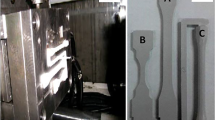Abstract
Plastic injection molding is an important process to produce thin-shell parts. However, the difficulty in adjusting optimum process conditions may cause defects of the injected-molded parts such as shrinkage. This study investigates on the optimum combinations of process conditions on shrinkage of an injected-molded part of the DVD-ROM cover based on Taguchi method. In doing this, a series of Moldflow analyses have been performed as per L27 orthogonal array design with each analysis by means of the process conditions of mold temperature, melt temperature, injection pressure, injection time, and cooling time. In the meantime, signal-to-noise (S/N) ratio is utilized to determine the optimum combinations of the process conditions for shrinkage through analysis of variance (ANOVA). ANOVA is further used to find which of the process conditions are statistically significant. Finally, confirmation tests at the optimum combinations of the process conditions were executed to verify the robustness and the effectiveness of Taguchi method within 95% confidence interval. From the findings, it can be stated that Taguchi method is a powerful tool for evaluating the defect of shrinkage in the plastic injection molding.
Similar content being viewed by others
References
Beaumont JP, Nagel R, Sherman R (2002) Successful injection molding. Hanser/Gardner, Cincinnati
Pötsch G, Michaeli W (1995) Injection molding: an introduction. Hanser, New York
Sors L, Balazs I (1989) Design of plastic moulds and dies. Elsevier Science, Hungary
Iyer N, Ramani K (2002) A study of localized shrinkage in injection molding with high thermal conductivity molds. J Inj Moulding Technol 6(2):73–90
Jansen KMB, Van Dijk DJ, Husselman MH (1998) Effect of processing conditions on shrinkage in injection molding. Poly Eng Sci 38(5):838–846
Jafairan AR, Shakeri M (2005) Investigating the influence of different process parameters on shrinkage of injection-molding parts. Am J Apply Sci 2(3):688–700
Demirer A, Soydan Y, Kapti AO (2007) An experimental investigation of the effects of hot runner system on injection moulding process in comparison with conventional runner system. Mater Des 28:1467–1476
Kurt M, Kaynak Y, Kamber OS, Mutlu B, Bakir B, Koklu U (2010) Influence of molding conditions on the shrinkage and roundness of injection molded parts. Int J Adv Manuf Technol 46:571–578
Chang TC, Faison E (2001) Shrinkage behavior and optimization of injection molded parts studied by Taguchi method. Polym Eng Sci 41(5):703–710
Altan M (2010) Reducing shrinkage in injection moldings via Taguchi, ANOVA, and neural network. Mater Des 31:599–604
Berginc B, Kampus Z, Sustaric B (2006) The use of the Taguchi approach to determine the influence of injection molding parameters on the properties of green parts. J Achiev Mater Manuf Eng 15(1–2):63–70
Liao SJ, Chang D, Chen HJ, Tsou LS, Ho JR, Yau HT et al (2004) Optimal process conditions of shrinkage and warpage of thin wall parts. Polym Eng Sci 44:917–928
Oktem H, Erzurumlu T, Uzman I (2007) Application of Taguchi optimization technique in determining plastic injection molding process parameters for a thin-shell part. Mater Des 28:1271–1278
Kopac J, Bahor M, Sokovic M (2002) Optimal machining parameters for achieving the desired surface roughness in fine turning of cold pre-formed steel workpiece. Int J Mach Tool Manuf 42:707–716
Lin TR (2002) Optimisation technique for face milling stainless steel with multiple performance characteristics. Int J Adv Manuf Technol 39:330–335
Gaitonde VN, Karnik SR, Davim JP (2008) Taguchi multiple-performance characteristics optimization in drilling of medium density fibreboard (MDF) to minimize delamination using utility concept. J Mater Process Technol 196:73–78
Taguchi G (1990) Introduction to quality engineering. Asian Productivity Organization, Tokyo
Ross PJ (1996) Taguchi techniques for quality engineering. McGraw-Hill, New York
Phadke MS (1989) Quality engineering using robust design. Prentice Hall, Englewood Cliffs
Yuin W, Alan W (2000) Taguchi methods for robust design, 1st edn. ASME, New York
Montgomery DC (2005) Design and analysis of experiments, 6th edn. Wiley, New York
Moldflow Corp (2004) Moldflow Plastic Insight 5.0 (MPI 5.0). Moldflow Corp, Framingham
Minitab Corp (2005) Minitab user manual, release 14. Making data analysis easier. Minitab Corp, Mc Graw-Hill Companies, Massachusetts, USA
Author information
Authors and Affiliations
Corresponding author
Rights and permissions
About this article
Cite this article
Öktem, H. Optimum process conditions on shrinkage of an injected-molded part of DVD-ROM cover using Taguchi robust method. Int J Adv Manuf Technol 61, 519–528 (2012). https://doi.org/10.1007/s00170-011-3750-3
Received:
Accepted:
Published:
Issue Date:
DOI: https://doi.org/10.1007/s00170-011-3750-3




